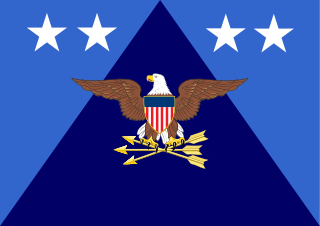Related Research Articles

The United States secretary of defense (SecDef) is the head of the United States Department of Defense, the executive department of the U.S. Armed Forces, and is a high-ranking member of the federal cabinet. The secretary of defense's position of command and authority over the military is second only to that of the president of the United States, who is the commander-in-chief. This position corresponds to what is generally known as a defense minister in many other countries. The secretary of defense is appointed by the president with the advice and consent of the Senate, and is by custom a member of the Cabinet and by law a member of the National Security Council.
The National Security Strategy (NSS) is a document prepared periodically by the executive branch of the United States that lists the national security concerns and how the administration plans to deal with them. The legal foundation for the document is spelled out in the Goldwater–Nichols Act. The document is purposely general in content, and its implementation relies on elaborating guidance provided in supporting documents such as the National Military Strategy.

William James Perry is an American mathematician, engineer, businessman, and civil servant who was the United States Secretary of Defense from February 3, 1994, to January 23, 1997, under President Bill Clinton. He also served as Deputy Secretary of Defense (1993–1994) and Under Secretary of Defense for Research and Engineering (1977–1981).

The deputy secretary of defense is a statutory office and the second-highest-ranking official in the Department of Defense of the United States of America.

William Sebastian Cohen is an American lawyer, author, and politician from the U.S. state of Maine. A Republican, Cohen served as both a member of the United States House of Representatives (1973–1979) and Senate (1979–1997), and as Secretary of Defense (1997–2001) under Democratic President Bill Clinton.
The U.S. Commission on National Security/21st Century (USCNS/21), also known as the Hart-Rudman Commission or Hart-Rudman Task Force on Homeland Security, was chartered by Secretary of Defense William Cohen in 1998 to provide a comprehensive review of US national security requirements in the 21st century. USCNS/21 was tasked "to analyze the emerging international security environment; to develop a US national security strategy appropriate to that environment; and to assess the various security institutions for their current relevance to the effective and efficient implementation of that strategy, and to recommend adjustments as necessary".

Ronald Jay Bath is a retired United States Air Force major general who directed U.S. Air Force Strategic Planning for the service's Deputy Chief of Staff for Plans and Programs at service headquarters in the Pentagon.
The National Military Strategy (NMS) is issued by the Chairman of the Joint Chiefs of Staff as a deliverable to the secretary of defense briefly outlining the strategic aims of the armed services. The NMS's chief source of guidance is the National Security Strategy document.

The United States under secretary of defense for policy (USDP) is a high level civilian official in the United States Department of Defense. The under secretary of defense for policy is the principal staff assistant and adviser to both the secretary of defense and the deputy secretary of defense for all matters concerning the formation of national security and defense policy.

Leslie Aspin Jr. was an American Democratic Party politician who served as the U.S. representative for Wisconsin's 1st congressional district from 1971 to 1993 and as the 18th United States Secretary of Defense under President Bill Clinton from 1993 to 1994.

The China Military Power Report, officially the Military and Security Developments Involving the People's Republic of China, is an annual report produced by the United States Department of Defense for the United States Congress that provides estimates, forecasts, and analysis of the People's Republic of China (PRC) military and security developments for the previous year. An unclassified form of the congressionally-mandated report is published publicly. The unclassified CMPR represents the most detailed, publicly-available source of information on the Chinese military.

The under secretary of defense for intelligence and security or USD(I&S) is a high-ranking civilian position in the Office of the Secretary of Defense (OSD) within the U.S. Department of Defense (DoD) that acts as the principal civilian advisor and deputy to the secretary of defense (SecDef) and deputy secretary of defense (DepSecDef) on matters relating to military intelligence and security. The under secretary is appointed as a civilian by the president and confirmed by the Senate to serve at the pleasure of the president.

The under secretary of defense for personnel and readiness, or USD (P&R) is a high-ranking civilian position in the Office of the Secretary of Defense (OSD) within the United States Department of Defense responsible for advising the secretary and deputy secretary of defense on recruitment, career development, pay and benefits, and oversight of the state of military readiness. The under secretary is appointed from civilian life by the president and confirmed by the Senate to serve at the pleasure of the President.

The United States Department of Defense is an executive branch department of the federal government of the United States charged with coordinating and supervising all agencies and functions of the U.S. government directly related to national security and the United States Armed Forces. As of June 2022, the U.S. Department of Defense is the largest employer in the world, with over 1.34 million active-duty service members, including soldiers, marines, sailors, airmen, and guardians. The Department of Defense also maintains over 778,000 National Guard and reservists, and over 747,000 civilians bringing the total to over 2.87 million employees. Headquartered at the Pentagon in Arlington County, Virginia, just outside Washington, D.C., the Department of Defense's stated mission is to provide "the military forces needed to deter war and ensure our nation's security".
The Advanced Distributed Learning (ADL) Initiative is a US government program that conducts research and development on distributed learning and coordinates related efforts broadly across public and private organizations. ADL reports to the Defense Human Resources Activity (DHRA), under the Director, DHRA. Although it is a DoD program, ADL serves the entire US federal government, operates a global partnership network including international defense ministries and US-based academic partners, and collaborates closely with industry and academia. ADL advises the DoD and US government on emerging learning technologies, best practices for improving learning effectiveness and efficiency, and methods for enhancing interoperability. Notable ADL contributions to distributed learning include the Sharable Content Object Reference Model (SCORM), Experience API (xAPI), and the DoD Instruction 1322.26.
The 2037 bomber was a short-lived 1999 United States Air Force proposal to modernize and extend the service life of the U.S. bomber fleet and defer the introduction of a replacement "capability" until 2037. The plan was criticized by lawmakers and Pentagon officials, some of whom believed the existing fleet was in danger of becoming outmoded and overstretched. Amidst this controversy, Air Force officials revised this plan in 2001 to put forward an accelerated timeline for a new bomber. Accordingly a Next-Generation Bomber program was started with the goal of introducing a bomber in 2018, but this was canceled in 2009. This program was restarted as the Long Range Strike Bomber which resulted in the Northrop Grumman B-21 Raider, currently expected to enter service in 2026–2027.

The Quadrennial Diplomacy and Development Review (QDDR) is a study by the United States Department of State, conducted beginning in 2009 and intended to be done every four years, that analyzes the short-, medium-, and long-term blueprint for the United States' diplomatic and development efforts abroad. It seeks to plan on a longer-term basis than the usual year-to-year, appropriations-based practice, and to integrate diplomacy and development missions. It similarly seeks to correlate the department’s missions with its capacities and identify shortfalls in resourcing. Finally, it is a precursor to core institutional reforms and corrective changes. The first review was completed by the end of 2010. A second review began during 2014 and was released in April 2015. No further reviews have taken place.

Penrose "Parney" C. Albright is an American physicist known for his work with the U.S. Government, think tanks and National Laboratories, and government contractors. Since November 1, 2014, he has been the president and CEO of HRL Laboratories, a research firm jointly owned by Boeing and General Motors. Until December 2013 he served as the director of Lawrence Livermore National Laboratory, and, in 2014, he served as a senior advisor in the Office of the Director of National Intelligence.

The chief management officer (CMO) of the United States Department of Defense (DoD) was the third-in-command of the department after the Secretary of Defense and Deputy Secretary of Defense. The position's purpose was to reduce costs by improving the quality and productivity of DoD's business operations. Congress disestablished the CMO position with the passage of the William M. (Mac) Thornberry National Defense Authorization Act for Fiscal Year 2021 effective 1 January 2021.
The National Defense Strategy (NDS) is produced by the United States Office of the Secretary of Defense (OSD) and is signed by the United States Secretary of Defense as the United States Department of Defense's (DoD) capstone strategic guidance. The NDS translates and refines the National Security Strategy (NSS) (produced by the U.S. President's staff and signed by the President) into broad military guidance for military planning, military strategy, force posturing, force constructs, force modernization, etc. It is expected to be produced every four years and to be generally publicly available.
References
- ↑ Karlin, Mara (2018-01-21). "How to read the 2018 National Defense Strategy". Brooking Institute. Retrieved May 1, 2018.
- ↑ Gould, Joe (2017-08-08). "QDR Dead in 2017 Defense Policy Bill". Defense News. Retrieved May 1, 2018.
- ↑ "Quadrennial Defense Review". Historical Office: Office of the Secretary of Defense. Retrieved May 17, 2024.
- ↑ "QDR 101: What You Should Know" (PDF).
- 1 2 Brake, Jeffrey D. "Quadrennial Defense Review (QDR): Background, Process, and Issues". Library of Congress Congressional Research Service. June 21, 2001
- ↑ Leslie Aspin, Jr., Report on the Bottom Up Review, "Section I: National Security in the Post-Cold War Era". October 1993
- ↑ Leslie Aspin, Jr., Report on the Bottom Up Review, "Section II: A Defense Strategy for the New Era". October 1993
- ↑ SECRETARY COHEN APPOINTS NATIONAL DEFENSE PANEL
- ↑ Legislation Describing a National Defense Panel for 2009/2010 – HR2647, section 1035
- ↑ Quadrennial Defense Review Report. February 6, 2006.
- ↑ Bennett, John T. (April 7, 2009). "Gates: Cutting FCS was tough". Army Times .
- ↑ QDR Panel Calls for More Force Structure Changes
- ↑ RIA Novosti Russia has objections over U.S. national security strategy - Foreign Minister